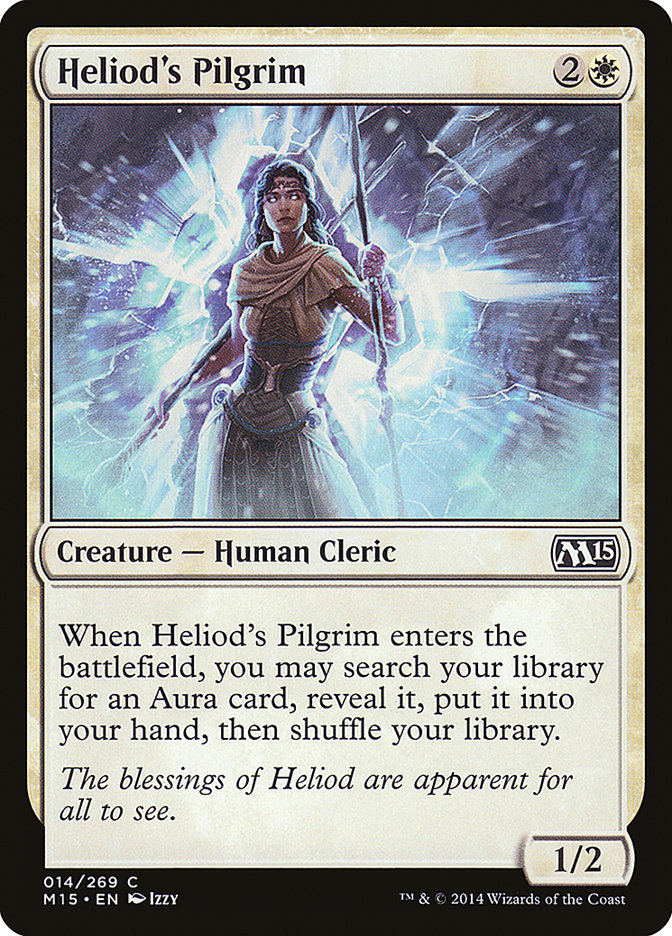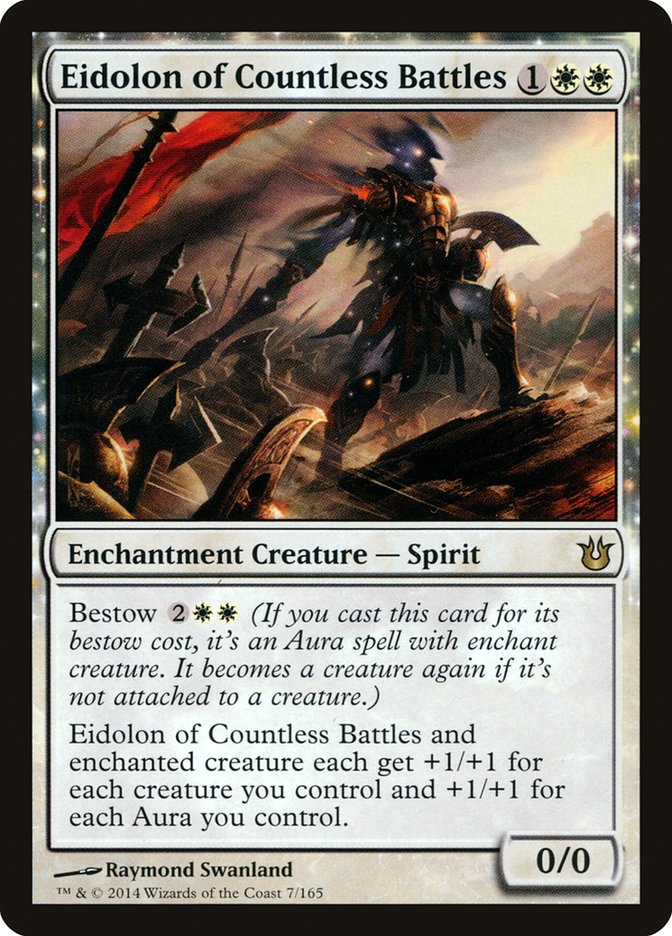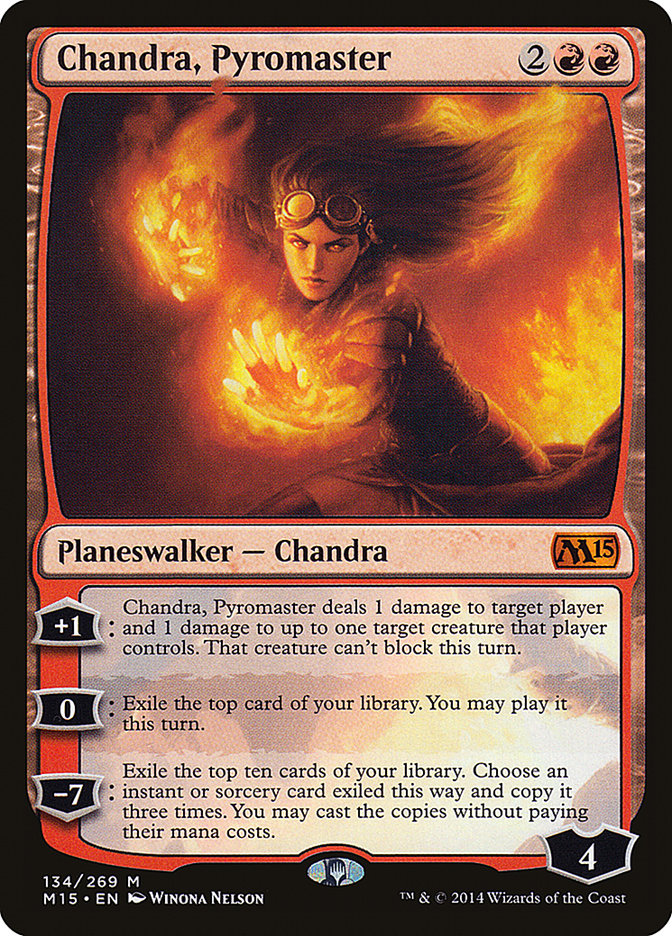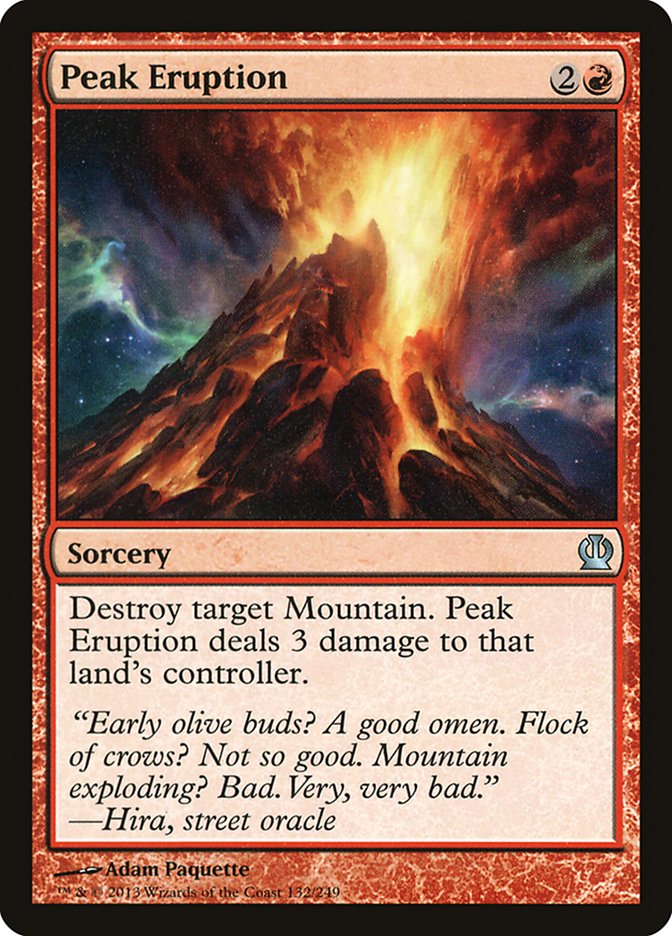Before I really started working on Standard, I started hearing about how W/U Heroic with Heliod’s Pilgrim was suddenly the best deck in Standard, and it
actually sounded really good to me. Justin, my testing partner for the event tried it (he had previously been working on various Mardu decks), and he
reported that winning with W/U Heroic was much easier than winning with the grindy Mardu decks he’d been playing. So I started there, and my results were
pretty good.
Despite the fact that I was winning a lot more than I was losing with W/U Heroic, it was started to get a lot of press, which was definitely a bad sign,
and I was consistently losing to Mardu. I decided this would be a deck I’d be satisfied to play if I had to, but I’d like to find something better.
For Grand Prix Ottawa, I ended up running into Craig Wescoe, who had lost contact with the people he’d been planning to stay with and was looking for
somewhere else to stay. We happened to have room in my hotel room, so Craig stayed with us. After dinner, when we went back to the room, he told me that he
had a W/R tokens deck that he was really excited about that he planned to play at Grand Prix San Antonio, and he thought he was going to do very well.
Craig and I have an interesting intersection on decks–I generally don’t think of myself as someone who likes to play the white aggressive decks he’s known
for, but we often end up exploring very similar paths while preparing for big events, as both of us are very open to using small creatures in unorthodox
ways, even if we ultimately settle in different places most of the time, and I’m a lot more likely to play blue.
Anyway, his W/R deck didn’t really look like my kind of thing, but I was open to suggestions and he was very confident, so I said I’d throw it together on
MTGO and have him walk me through some matches and we’d see how it did. We won an 8-man pretty easily and then some other matches, and I agreed that the
deck looked pretty sweet.
His list at the time was:
Creatures (13)
Planeswalkers (2)
Lands (24)
Spells (21)
- 3 Magma Jet
- 3 Raise the Alarm
- 4 Chained to the Rocks
- 3 Lightning Strike
- 4 Stoke the Flames
- 4 Hordeling Outburst
Sideboard

Craig described the deck as a Wingmate Roc deck–the whole deck was designed to make sure that you could always trigger raid on turn 5 by playing cards
that would leave you with some creatures in play. Wingmate Roc trumps most things people are doing in the format other than Stormbreath Dragon and Hornet
Queen. I’ve thought Wingmate Roc was a pretty outstanding card from when I first saw it spoiled, so I could certainly get behind building around it.
I learned a lot about how Craig approached sideboarding by playing with him. He wanted to keep the aggressive core of the deck, but tweak his removal to
match the opponent’s threats. He wouldn’t bring in all the Glares or Erases just because the opponent had some things he could kill. Chandra almost always
came in, which was one of the things I liked most about the deck. Chandra’s great in post-sideboard games when you have all the right answers to reveal.
I told Justin I liked W/R and asked him to work on it. He’d previously worked on some Mardu tokens decks, so he was somewhat familiar with the strategy,
and began investigating options that lowered the curve for Monastery Swiftspear and tried Prophetic Flamespeaker.
Robert Hatch, whose Heliod’s Pilgrim W/R deck was featured in Gerry’s Daily Digest, wrote me to say that he’d been doing really well with that deck. I said
I’d looked at it, and that Heliod’s Pilgrim looked good, but I didn’t like losing Chandra, Pyromaster, and I didn’t understand putting all the threats in
the sideboard. He told me that all his opponents expect W/R to become more controlling, and he wanted to surprise them. I’m skeptical of that strategy in
general, but I knew it definitely wouldn’t work in a tournament where we could see each other’s decklists. Still, I liked his approach of using Heliod’s
Pilgrim and Eidolon of Countless Battles over Goblin Rabblemaster to make Hero’s Downfall and Lightning Strike bad.
So I basically just took everything I liked from each of these decks to build a deck that did what I wanted–it could pressure people early to get them
into burn range and take advantage of the explosive power of Wingmate Roc and Eidolon of Countless Battles, and transform against green decks into a
control deck with a lot of great removal and fliers.
The deck I submitted was:
Creatures (18)
- 3 Eidolon of Countless Battles
- 3 Heliod's Pilgrim
- 4 Wingmate Roc
- 4 Seeker of the Way
- 4 Monastery Swiftspear
Planeswalkers (2)
Lands (24)
Spells (16)
Sideboard

Monastery Swiftspear is the card that most people have talked to me about cutting, and it was the last card I added to the deck, so it’s the card I’m least
sure about. I think it was pretty good for me, and I like that it lets me get a threat down early and get a lot of damage in while I’m killing each of my
opponent’s blockers as they play them, and it generally just keeps my opponent behind if they’re trying to use removal to catch up. People want to cut it
for Brimaz, King of Oreskos or Goblin Rabblemaster, but I like having the lower curve, which lets me take better advantage of Chandra, Pyromaster by
playing two spells in one turn, and generally it makes my deck really hostile against people who are playing spot removal.
Heliod’s Pilgrim is the major innovation that I think has been underplayed in this archetype in the past. We’ve seen the success of adding the card to W/U
Heroic, but with Chained to the Rocks, it’s basically a (much?) better Fiend Hunter–it exiles any creature and gives you a small body, but with Heliod’s
Pilgrim in exchange for needing to spend an extra mana, you get the ability to play it in advance of the creature you actually want to kill, and their
creature stays gone even if they kill your creature. Both of these differences are huge. Moreover, a 1/2 body is actually much better in this format than
it usually is because it both bricks opposing Hordeling Outbursts and triggers raid.
It’s worth specifically noting that Heliod’s Pilgrim cannot find Eidolon of Countless Battles. For some people, who think at first that it can, the
disappointment of finding out that it can’t might make them think the synergy isn’t good, and these cards don’t belong in the same deck. That couldn’t be
further from the truth. Heliod’s Pilgrim is still a great creature to bestow onto because you’ve invested so little in it, and it gives you more functional
copies of Chained to the Rocks, which each pump the Eidolon.
Speaking of Eidolon of Countless Battles, this is a card that looks very powerful on paper, but which has generally disappointed in practice. It’s great in
this deck, as it both has strong synergies with the token strategy and gives the deck that is already very good at going wide an ability to go big,
breaking through opposing blockers and demanding chump blocks very early. Also, the synergy with Seeker of the Way is outstanding, as it triggers prowess
when cast with bestow, giving you a huge lifelinking attacker, which can immediately swing a race in your favor.
Most of the earlygame threats are functionally just a distraction to set up a position where your opponent is on the backfoot, and Wingmate Roc puts the
game away, and I can’t say enough about how powerful the card is in this deck.
What really puts the deck over the top for me is the sideboard.
In Modern, I wrote out my sideboard plans for each of the major matchups. I didn’t do that in Standard because I knew that very subtle changes in my
opponent’s decklist could substantially change what I’d want to do in sideboarding. I’d also played more matches with the deck and trusted myself to figure
out what I wanted to do on the fly. For those of you who haven’t, let me try to explain the basics. I’ll start by going through my tournament because I
think that offers some good examples.
In the first round, I played against Ivan Floch with U/B Control. Clearly removal is bad here, so I wanted to cut four Chained to the Rocks and three
Heliod’s Pilgrim. Erase and Glare of Heresy don’t do anything, so there are eight cards in my sideboard I could bring in. I brought all of them in and cut
a Wingmate Roc, because it’s very hard to resolve Wingmate Roc or trigger raid. I could see bringing in one less Arc Lightning instead, as Arc Lightning is
pretty bad since it’s a three-mana Lava Spike, but I actually like having burn against them. You can often get them pretty low with your early threats, but
then they answer all of them and start drawing cards and looking to lock up the game before they finally find a way to close. Because they need a lot of
removal, their counterspells might be limited, and in the later stages of the game, often all you want to do is draw a burn spell or two to finish the
game.
In my second round, I played against Shahar Shenhar’s Sultai Reanimator. He had two Reclamation Sages in his sideboard and no large creatures that I really
needed to kill. I decided I’d cut my Chained to the Rocks and Heliod’s Pilgrims again, hoping to strand his Reclamation Sages. Hornet Queen was the card I
was most worried about. My best answers to it were Arc Lighting, Chandra, Pyromaster, and Ashcloud Phoenix. All of those are awkward answers, but they gave
me some chance. Ideally, I’d just win before Hornet Queen could be cast, but I did want all of my outs if that didn’t happen.
Because Shahar had Doomwake Giant, I wanted to move away from tokens a little, so I was comfortable cutting some number of Hordeling Outbursts and Raise
the Alarm. From my 75, I removed 4 Glare of Heresy, 4 Chained to the Rocks, 3 Heliod’s Pilgrim, and 4 Hordeling Outburst.
In my third round, I played against Owen Turtenwald with G/B Constellation. Owen’s deck was very similar to Shahar’s in that it was dedicated to filling up
the graveyard to find Whip of Erebos with Hornet Queen, but unlike Shahar, Owen had four copies of Arbor Colossus in his sideboard, and my Erases were more
taxed answering Owen’s other constellation cards, so I’d want Chained to the Rocks to help answer Doomwake Giant.
So against Owen, the fifteen cards I didn’t want were 4 Glare of Heresy, 3 Lightning Strike, 3 Raise the Alarm, 4 Hordeling Outburst, 1 Eidolon of
Countless Battles.
For my fourth match, I played against Yuuki Ichikawa’s Abzan Reanimator deck. This was another Hornet Queen + Whip of Erebos deck–definitely not the
pairings I was hoping for in this tournament, as I think my deck really shines against aggro and Mardu. Again, Erase was going to be extremely important,
but unlike my previous matchups, here I’d want Glare of Heresy because Yuuki had Siege Rhino, Wingmate Roc, and Soul of Theros. Given all the answers I had
to bring in, my plan was to become a dedicated control deck, which definitely feels weird against a deck that looks to have so much more power. This is a
spot where Chandra and Ashcloud Phoenix are critical for generating inevitability.
The fifteen cards I didn’t play in game 2 were 4 Hordeling Outburst, 3 Raise the Alarm, 2 Eidolon of Countless Battles, 3 Lightning Strike, and 3 Stoke the
Flames. My plan was to play a prowess creature and kill his threats, then stick Chandra to make sure he couldn’t get back in it. If I didn’t draw Chandra,
I could still either win by getting in too much damage while answering his first threats or, more likely, by trading enough to win by attrition because he
has so many more mana sources thanks to Elvish Mystic, Sylvan Caryatid, and Satyr Wayfinder.
As this indicates, in general, I’m much less committed to keeping the aggressive token core of my deck than Craig Wescoe was with his version because
Ashcloud Phoenix offers a reliable finisher when I want to become a control deck.
While I bring Chandra, Pyromaster in against basically everyone, I don’t always bring Ashcloud Phoenix in. Ashcloud Phoenix is best against green decks and
control decks, but it’s not what I’m looking for against aggro.
Against W/U Heroic, I’m most concerned with killing their threats. If you answer their creatures, they fold to Wingmate Roc, and it’s easy for Chandra to
keep you ahead. Here, the cards I wouldn’t want are 3 Erase, 3 Ashcloud Phoenix, 3 Eidolon of Countless Battles, 4 Hordeling Outburst, and 2 Arc Lightning.
I want Raise the Alarm over Hordeling Outburst because I want to be able to hold mana up on my opponent’s turn to represent Lightning Strike and then play
a threat if I don’t need to use it or after they’ve had to make a different play because I had mana up. Also, I want to be able to curve out a little
better and play a threat more often before playing a Heliod’s Pilgrim. I don’t need the extra pressure offered by Hordeling Outburst. I’m happy to have any
clock or even just a few chump blockers. It’s worth noting that I’m pretty sure you don’t want Erase even though they have a lot of enchantments because
they’re all auras, and you’d rather just answer the creatures.
Against Mono-Red Heroic, the tokens and cheap creatures really shine, and it’s really hard for them to get ahead. Heliod’s Pilgrim is a solid two-for-one,
your lifegain can be a huge problem for them, and Chandra is just outstanding. In the sideboard, Arc Lightning is another nightmare.
The cards you don’t want against them are 4 Glare of Heresy, 3 Erase, 3 Eidolon of Countless Battles, 3 Ashcloud Phoenix, and 2 Stoke the Flames.
Against Mardu Midrange, your goal is to answer their threats and punish their reliance on spot removal against your threats that go wide. You’re already
really well-positioned against them, so sideboarding will be minimal, and will depend slightly on their list. I would generally do something along the
lines of cutting three Eidolon of Countless Battles for two Chandra, Pyromaster and a Glare of Heresy.
The 75 offers a lot of play in terms of tuning your threats and answers. When you really want to go wide, you can cut cheap creatures to focus on tokens.
Against Doomwake Giants and other cards that are good against tokens, you can just remove the tokens. If an opponent shows you multiple Erases, you can
usually cut all your Chained to the Rocks, Eidolon of Countless Battles, and Heliod’s Pilgrims. Most of your cards are versatile enough that there’s a lot
of room to keep your opponent’s guessing and shift gears to answer the exact set of cards your opponents have, so don’t be afraid to get a little creative
in sideboarding with this deck.
The most common question now would be whether there are any changes I would make after the tournament. At this exact moment, I’m watching a live deck tech
with Team Brazil, which is using an updated version of my deck with Goblin Rabblemaster over Monastery Swiftspear, and Peak Eruption in the sideboard over
Ashcloud Phoenix.
Peak Eruption is a great choice if they expect a lot of the mirror, which wasn’t a factor for me when I was preparing, so I can respect trying to include
the card, but I don’t like cutting Ashcloud Phoenix, which as I’ve discussed, I think is really important to the deck’s sideboard plans. They lost to U/B
Control because they didn’t have it. Seeing the coverage continue, I see that they possibly dropped Ashcloud Phoenix to make room for it in the G/R
Monsters deck they were playing alongside it (though I think that deck is only using three, so I’m not sure why they didn’t give the W/R deck the fourth).
I played Goblin Rabblemaster before I switched to Monastery Swiftspear, and I did also have good results with it. I prefer Swiftspear, but I think that if
you expect very little spot removal, Goblin Rabblemaster can make sense. Another consideration in that spot should be Prophetic Flamespeaker, however,
which is amazing with Eidolon of Countless Battles. If you go that direction, I’d consider playing a Hammerhand or Dragon Mantle to find with Heliod’s
Pilgrim.
Another card that was suggested is Barrage of Boulders as a slightly better answer to Hornet Queen than Arc Lightning. I like the idea, as Hornet Queen is
a huge problem, and Arc Lightning doesn’t fully solve it, but it’s not a clear change to me, as Arc Lightning is a lot better when they don’t have exactly
Hornet Queen. Several times in the tournament I’d just use Arc Lightning to kill a 1/1 blocker, trigger prowess, and hit my opponent for two damage.
Overall, I think some tweaks are reasonable, and I agree that Monastery Swiftspear is one of the more reasonable cards to remove, but I was happy with the
deck, and there’s nothing I feel like I’d really urgently need to change.





